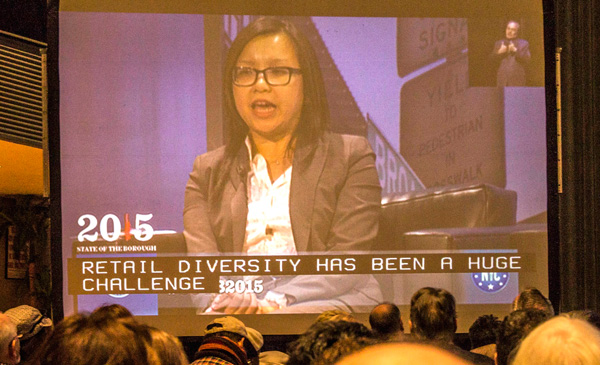
BY ZACH WILLIAMS | Instead of a traditional State of the Borough speech, Manhattan Borough President Gale Brewer opted to host a panel discussion on Feb. 8 regarding the future of local communities.
The hour-long discussion covered a wide range of topics, including affordable housing, education and community-police relations. Brewer also emphasized the role of technology in grassroots politics by staging a social media campaign to accompany the event, which was held up at Columbia University.
Twitter posts with the hashtag #SOTB2015 streamed audience questions and comments onto a projection screen during the panel discussion. Local elected officials meanwhile posted their own six-second videos summarizing their ambitions for the upcoming year via the social media Web site Vine.
“I really do believe in getting different ideas to solve problems,” Brewer said in an interview.
She said an emphasis on youth brought Community Board 3 Chairperson Gigi Li to the panel, where she joined H. Carl McCall, the former state comptroller and current SUNY board of trustees chairperson; Ruth Messinger, the former former Manhattan borough president; and Jaime Estades, president of the Latino Leadership Institute.
The panelists all agreed that more affordable housing will be needed to maintain middle- and low-income populations within the borough. Local community members need to maintain input throughout the development of affordable housing, said Li. As an example of an engaged community planning process, she touted the Seward Park Urban Renewal Area (SPURA), where more than half of the 1,000 new units to be built will be affordable. People with a long-running presence in the neighborhood should receive preference for new units, she added.
Many affordable housing projects are constructed under a so-called “80/20” plan — such as the Extell development underway on Cherry St. — under which a builder receives tax breaks in exchange for making 20 percent of the units affordable. But many affordable housing activists and local residents say that framework offers too much to developers and not enough housing for community needs. Plus, the units created are not permanently affordable.
New market-rate housing in the East Village and Lower East Side also reflects the changing commercial orientation of the areas, which today host a booming nightlife. Community leaders need to confront prospective businesses and urge them to open shops that benefit local neighborhoods rather than just another loud bar, Li suggested.
“Retail diversity has been a huge challenge in the Lower East Side and East Village where we are seeing a predominance of a particular type of industry,” she said.
Improvements in the quality of high school education are also crucial to improving neighborhoods and aiding social mobility, noted McCall. Rising graduation rates are encouraging, but less so if students reach college only to enroll in remedial courses, McCall stressed.
“The biggest issue we face right now is the fact that the students who are coming to us from New York high schools are not prepared for college,” he said.
More technology could help reverse that, said Brewer. As The Villager reported last July, $480,000 in new funding came to Lower East Side schools last year for laptop computers, as well as interactive whiteboards and tables, the latter which are basically large, horizontal tablet computers. Teachers with a pre-Digital Age skillset need more training, Messinger said. Low-income families still face financial barriers to accessing pricey tech tools, Eastades added.
Schools could also encourage a greater appreciation for healthy eating and environmental sustainability, according to Brewer. She said that New York City was the second-biggest purchaser of food nationwide after the U.S. Department of Defense. Yet, applesauce for school children comes from China, she said, to gasps from the audience. Such purchases should be made from New York farmers, according to Brewer.
Grassroots efforts can help improve frayed relations between the New York Police Department and local communities, the borough president added. At a recent forum in Upper Manhattan co-hosted by Brewer, private citizens engaged police brass and politicians in small groups, rather than in a town hall-style format that limits the ability for individual participants to directly engage each other, she said.
“It wasn’t a microphone situation,” Brewer explained of the Jan. 30 forum. “People really exchanged ideas.”
Such sentiments were the common theme throughout last Sunday’s event, at which panelists and Brewer urged that legislative and community initiatives must follow a bottom-up approach based on residents’ views. For the elderly that can mean determining bus routes by how many local seniors actually want them, said Brewer.
For Li, that spirit translates well into immigrant-heavy areas of the borough, such as the Lower East Side. Government and community services should reflect an enclave’s inherent diversity rather than merely adapting to it, according to Li.
“I think something what’s very important is cultural competency, communication, having police officers that speak the language,” she said, “understand the culture and neighborhoods they are patrolling in.”

















